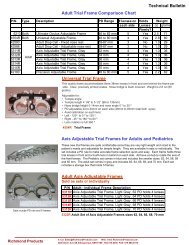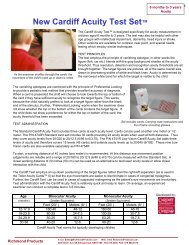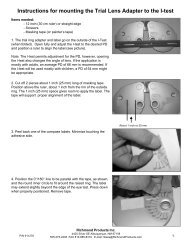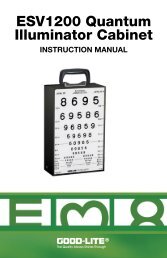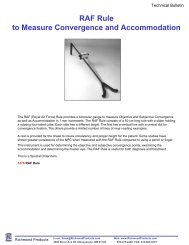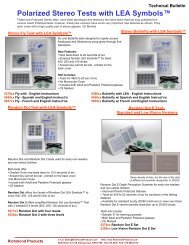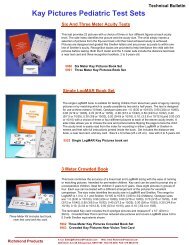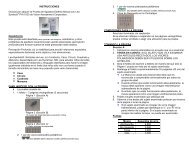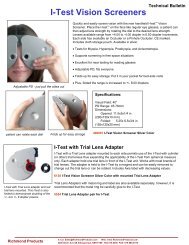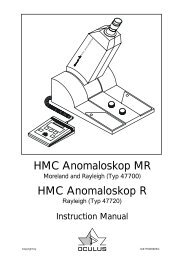Pacific Acuity Test - 360000 - Good-Lite Company
Pacific Acuity Test - 360000 - Good-Lite Company
Pacific Acuity Test - 360000 - Good-Lite Company
Create successful ePaper yourself
Turn your PDF publications into a flip-book with our unique Google optimized e-Paper software.
<strong>Pacific</strong> <strong>Acuity</strong> <strong>Test</strong> - <strong>360000</strong><br />
The <strong>Pacific</strong> <strong>Acuity</strong> <strong>Test</strong> is a vanishing optotype test designed<br />
with opposing figures to provide a simple forced-choice testing<br />
format appropriate for nonverbal children and individuals with<br />
developmental disabilities who are unable to respond to standard<br />
optotype recognition tests. Each card has two figures, a<br />
simple face, and an opposing oval target of the same overall size<br />
but with interior details that allow discrimination from the face at<br />
the threshold of acuity. The vanishing optotype design significantly<br />
reduces the difference in the threshold between detection<br />
and recognition acuity. However, by using a similar opposing figure,<br />
the <strong>Pacific</strong> <strong>Acuity</strong> <strong>Test</strong> requires contour analysis and visual<br />
discrimination. This format yields a more accurate measure of<br />
acuity than traditional preferential looking tests, particularly with<br />
children who have significant visual impairment.<br />
The <strong>Pacific</strong> <strong>Acuity</strong> <strong>Test</strong> is appropriate for preschool children aged<br />
6 months and older. While developing the test, we found many<br />
children between 6 and18 months will respond to the standard<br />
test paradigm showing a clear preference for the face. However,<br />
most children over age 18 months can respond well to this testing<br />
format to yield reliable and accurate results. For children under<br />
18 months better testability can be achieved by using the<br />
mask provided to present only one optotype (face).<br />
It is important to understand that the <strong>Pacific</strong> <strong>Acuity</strong> <strong>Test</strong> is not<br />
equivalent to a standard optotype recognition test like LEA Symbols<br />
or Snellen. However, it does provide an acuity measure that<br />
is close to isolated single symbol tests and can be used to detect<br />
significant visual impairment and inter-ocular difference in cases<br />
of suspected amblyopia or unilateral pathology in children who<br />
are cooperative for monocular acuity assessment.<br />
<strong>Test</strong> Administration<br />
The full test kit consists of 18 cards with two cards at each level.<br />
The cards at each acuity level have a different position of the<br />
face target compared to the opposing oval figure. Each card<br />
can be presented at either 50 cm or 1 meter but the 1 meter test<br />
distance is recommended for greater accuracy and comparison<br />
to distance visual acuity tests. The test range from 1.3 LogMAR<br />
(20/400) down to 0 LogMAR (20/20) allows for testing a broad<br />
range of visual acuity. (see chart below)<br />
It is important to have adequate lighting but be careful to avoid<br />
direct lighting at an angle that creates glare on the card surface.<br />
The clear coat used on each card improves durability but can<br />
create glare with direct lighting positioned behind and above the<br />
patient.<br />
1. For most children, we recommend starting with the 1.0 Log-<br />
MAR (20/200) card and use that level to introduce the child to<br />
the test paradigm. If the child has visual impairment, the 1.3<br />
LogMAR(20/400) level card can be used.<br />
2. The test administrator should shuffle the cards at each level<br />
so that they are not aware of the position of the face prior to<br />
presenting each card.<br />
3. Present a card at 1 meter and ask the patient, “Where is the<br />
boy”? We have found that testability improves if the examiner<br />
gives the face a name. It is important to be consistent since it<br />
is the same face used on each card. Observe the child’s fixation.<br />
The child should respond by looking at each figure before<br />
making a “decision” and either fixating preferentially on the<br />
face, pointing or saying up or down if verbal. Encourage the<br />
patient to point to the face and reward the child for responding.<br />
Positive reinforcement is critical to testability. As the child<br />
reaches the threshold of acuity, even incorrect responses<br />
should be rewarded.<br />
1.800.362.3860<br />
www.good-lite.com 1.888.362.2576 Fax 1
<strong>Pacific</strong> <strong>Acuity</strong> <strong>Test</strong> Continued<br />
4. If the patient responds easily to the 20/200 card level (both<br />
cards), we recommend moving to the 20/100 level next. If the<br />
child is able to respond to 2 successive cards at any level,<br />
move on to the next. When the child begins to have difficulty<br />
discriminating the targets (near threshold), it is important to<br />
perform at least 3 card presentations at that level. Threshold<br />
should be the last level in which the child is able to get at least<br />
2 out of 3 card presentations correct but more presentations<br />
can be done to increase certainty at and below threshold.<br />
Make sure to shuffle the cards after each presentation so that<br />
the patient nor the examiner can guess the position of the face.<br />
5. For children below age 18 months, we recommend using the<br />
mask provided to create a single optotype (face only) presentation.<br />
Although this will yield a detection acuity without a<br />
recognition component, infants and toddlers respond much<br />
better to a single optotype. It is possible to use the 2-optotype<br />
recognition task with children younger than 18 months<br />
as many will respond by clearly showing a gaze preference for<br />
the face. The clinician should evaluate the child’s responses<br />
and use the test paradigm that will yield the most success in<br />
reaching a clear threshold.<br />
Snellen Equivalent<br />
at 50 cm<br />
LogMAR<br />
Snellen Equivalent<br />
at 1 meter<br />
LogMAR<br />
400 1.3 200 1.0<br />
200 1.0 100 0.7<br />
160 0.9 80 0.6<br />
127 0.8 63 0.5<br />
100 0.7 50 0.4<br />
80 0.6 40 0.3<br />
63 0.5 32 0.2<br />
50 0.4 25 0.1<br />
40 0.3 20 0<br />
1.800.362.3860<br />
www.good-lite.com 1.888.362.2576 Fax 2



